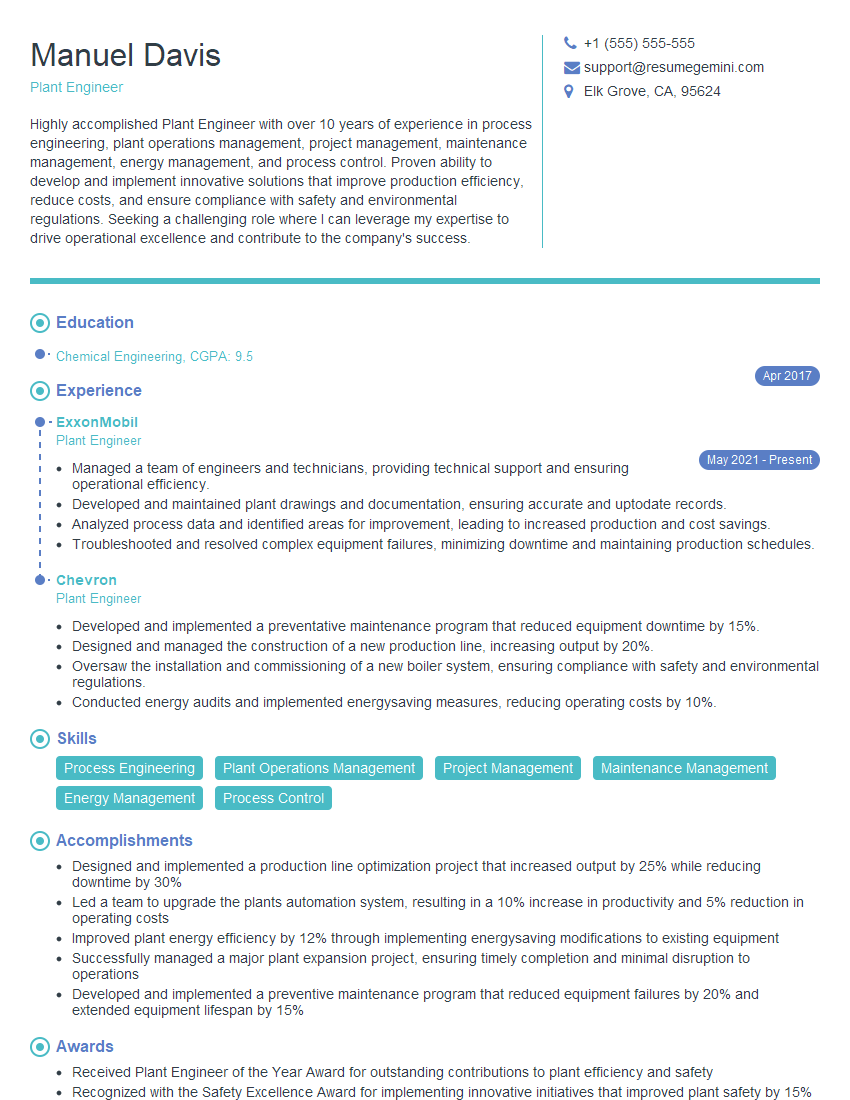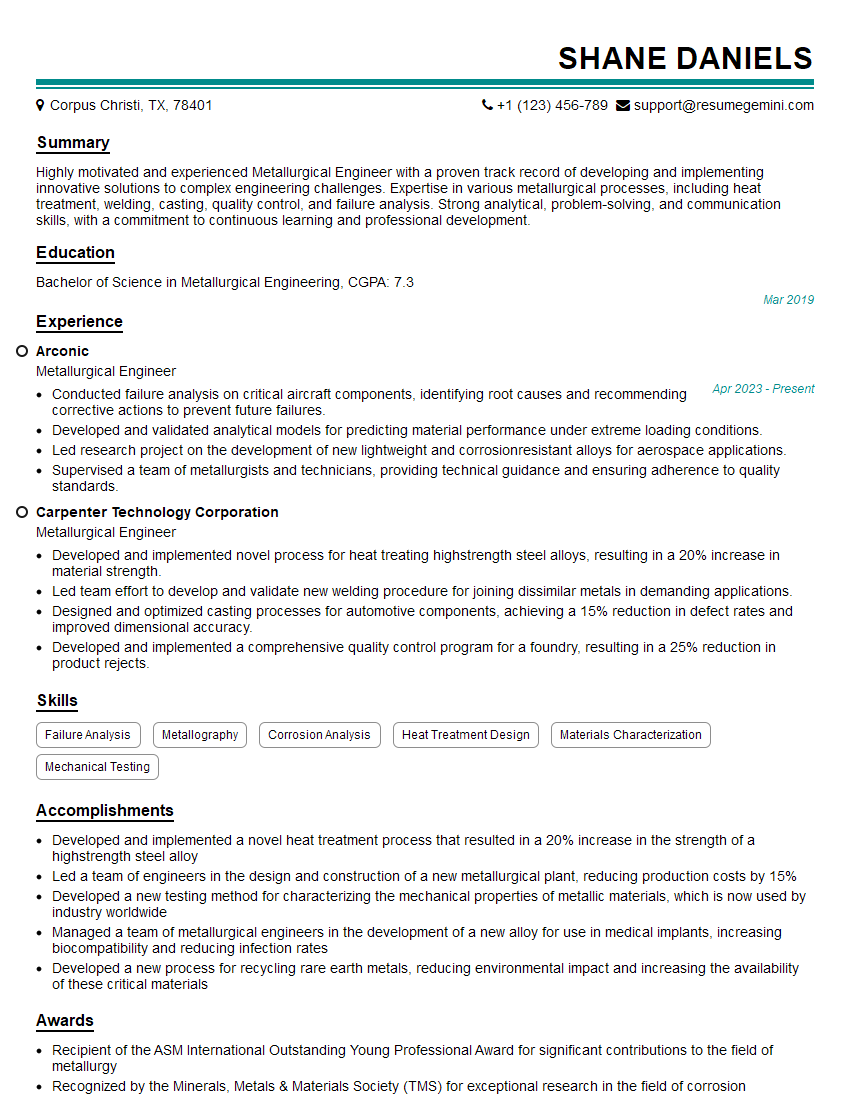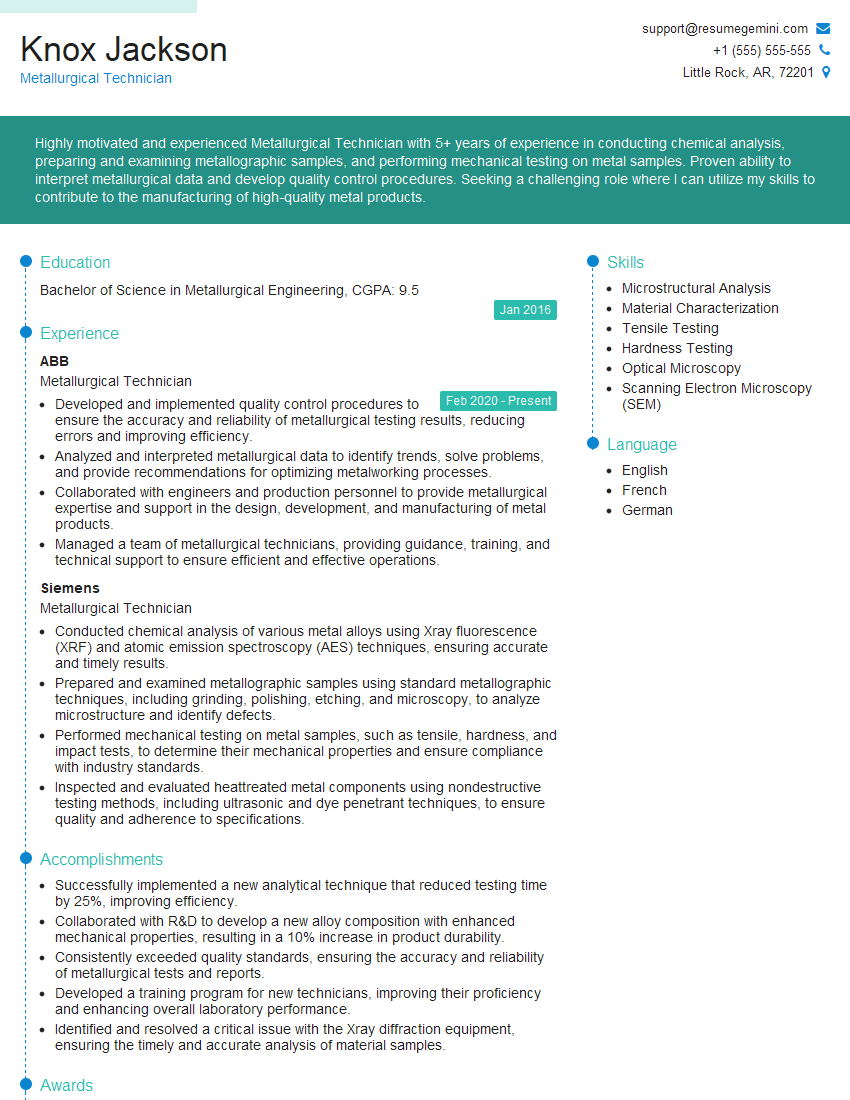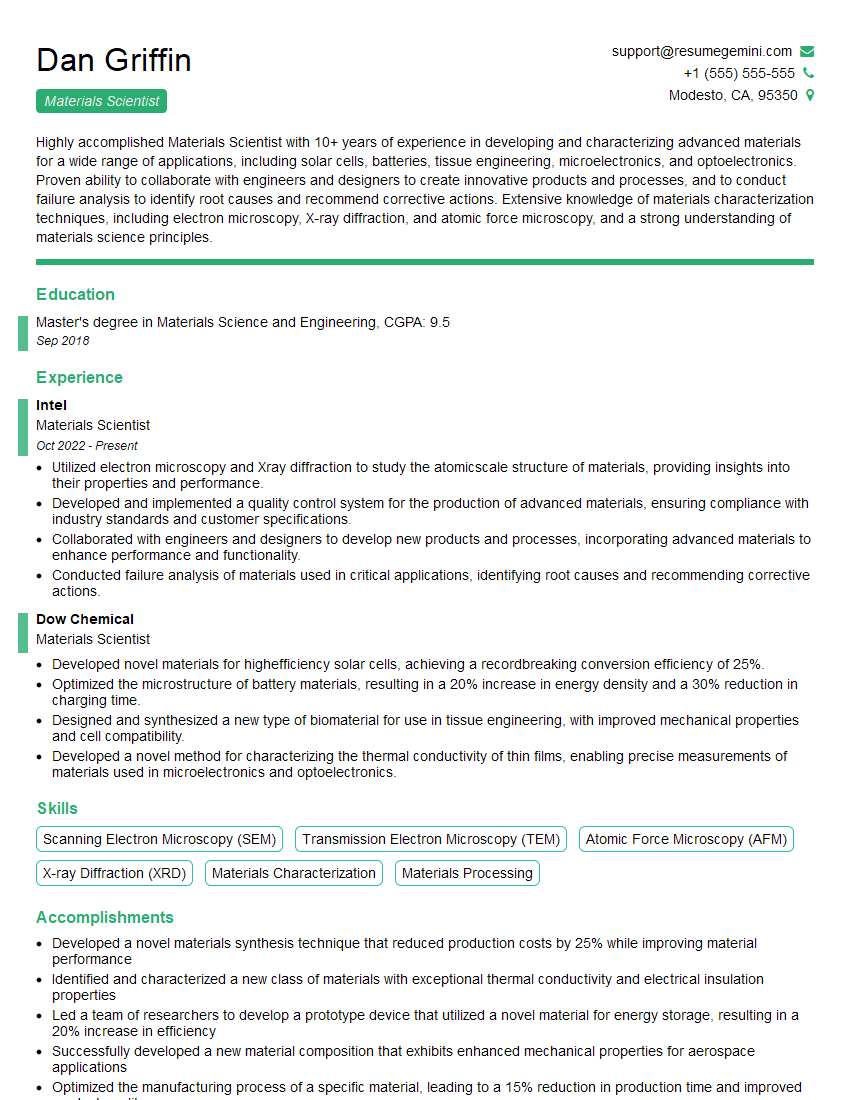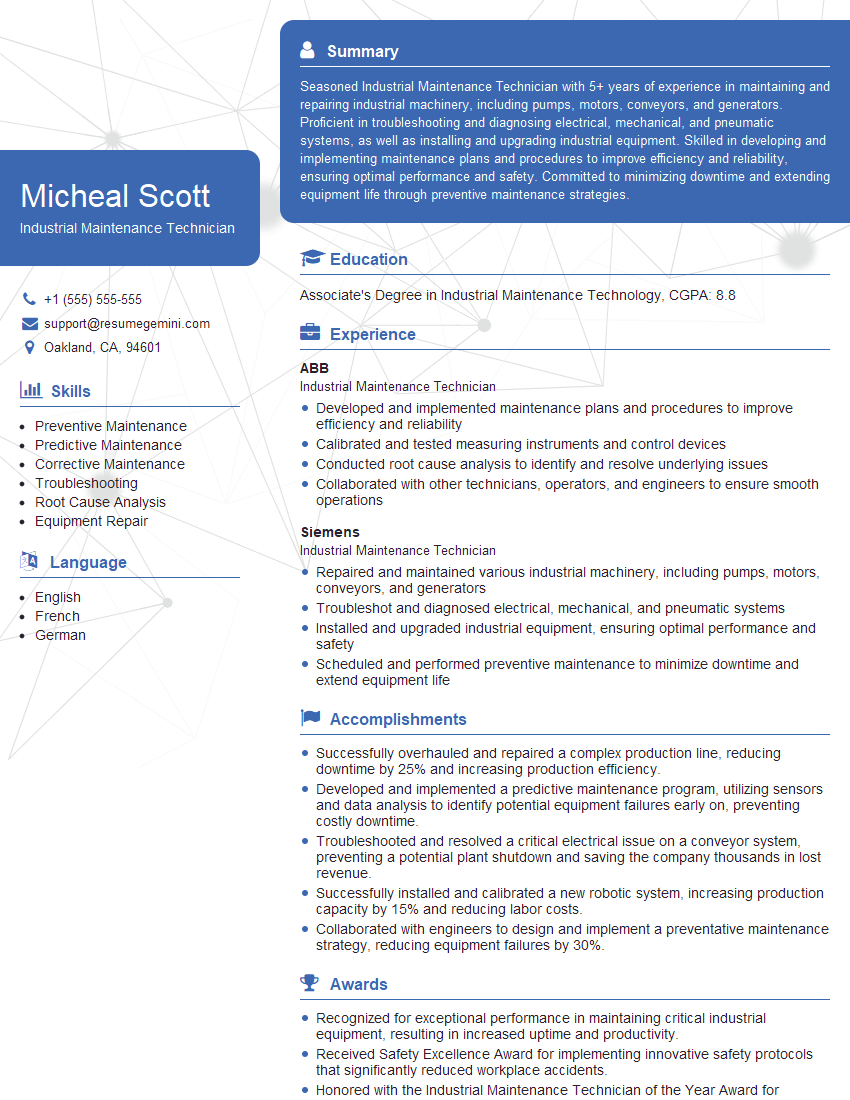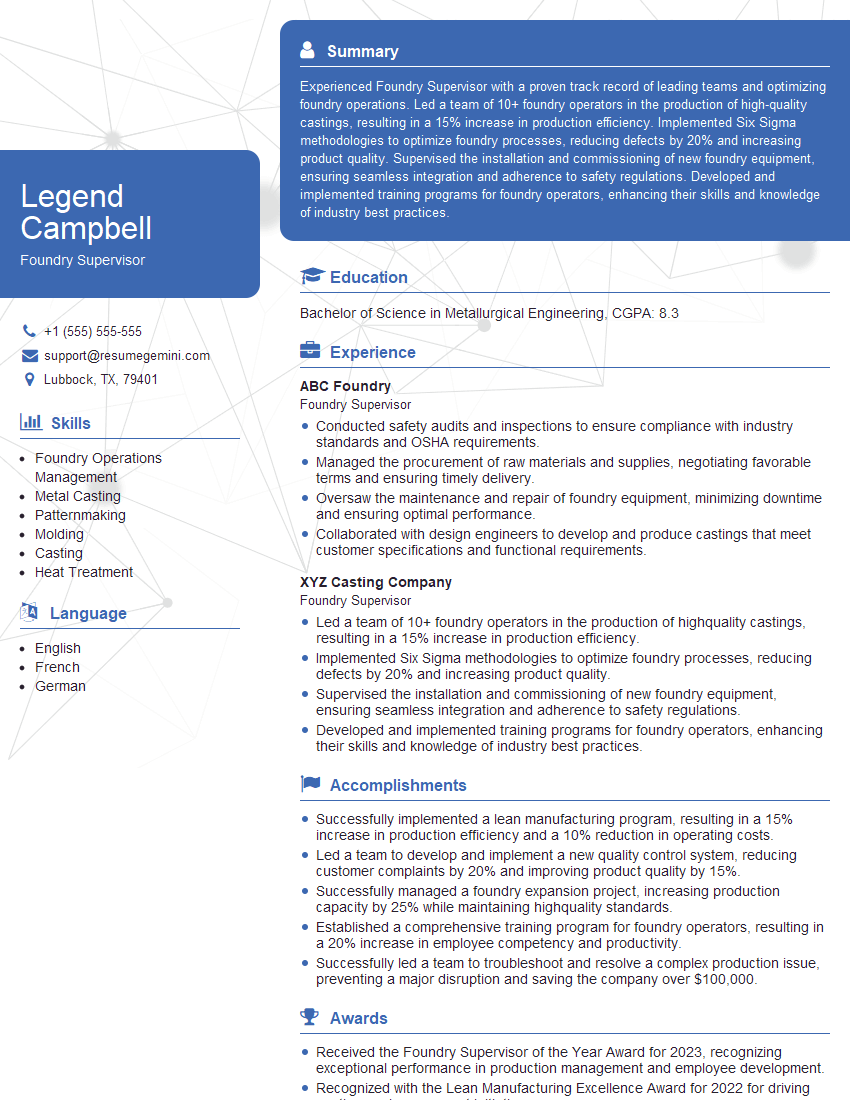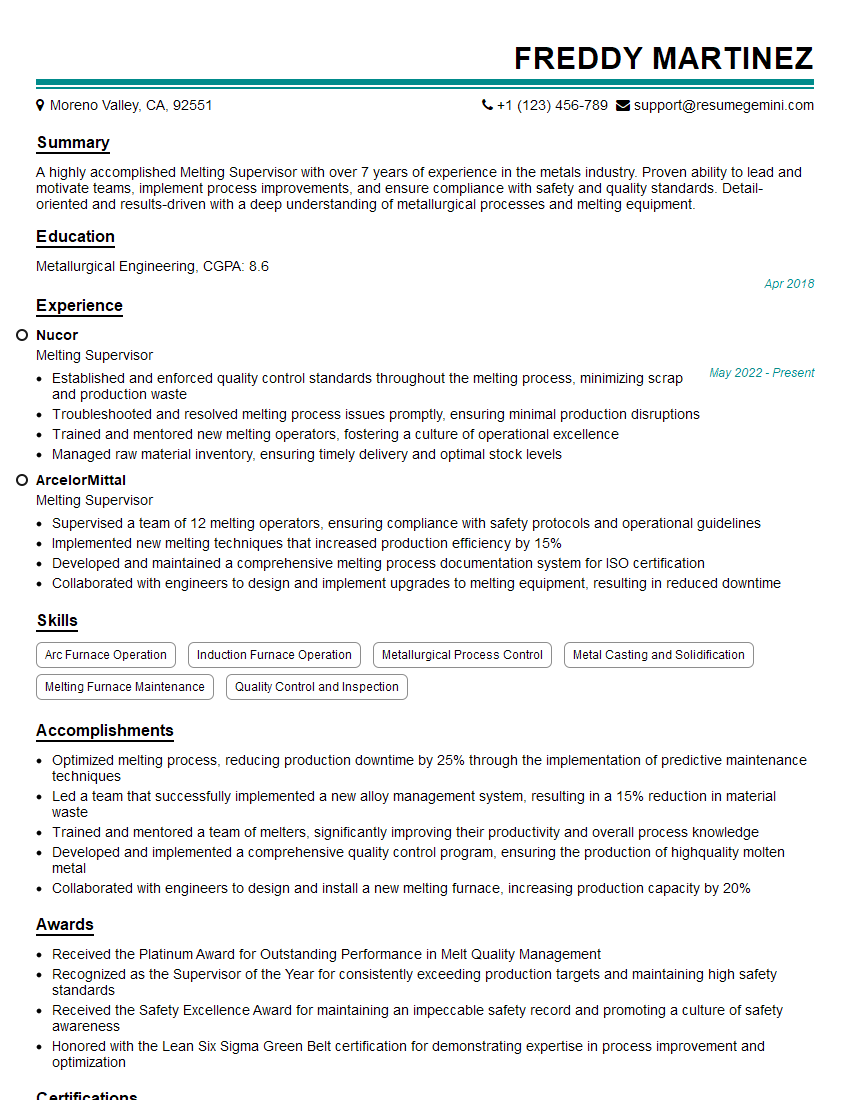Preparation is the key to success in any interview. In this post, we’ll explore crucial Cupola Troubleshooting interview questions and equip you with strategies to craft impactful answers. Whether you’re a beginner or a pro, these tips will elevate your preparation.
Questions Asked in Cupola Troubleshooting Interview
Q 1. Explain the process of cupola charging and its impact on metal quality.
Cupola charging is the process of systematically adding the charge materials – iron, coke, and limestone – into the cupola shaft. The order and method of charging significantly impact the quality of the molten metal produced. Think of it like baking a cake; the order and proportion of ingredients matter greatly.
- Proper layering is crucial: A typical charge consists of layers of coke, iron, and limestone. Coke provides the heat for melting, iron is the primary metal being melted, and limestone acts as a flux to remove impurities. Incorrect layering can lead to inefficient melting and poor metal quality.
- Charge size and distribution: The size and distribution of the charge materials affect the uniformity of the melting process. Too large a charge might cause bridging (blocking the airflow) while too small a charge might lead to uneven melting.
- Charging rate: The rate at which the charge is added should be carefully controlled to maintain consistent melting and temperature. A sudden influx of charge can disrupt the process and negatively impact metal quality.
- Impact on Metal Quality: Inconsistent charging can lead to variations in the metal’s chemical composition, temperature, and fluidity. These variations can result in defects in the castings, such as porosity, inclusions, and variations in mechanical properties. For example, insufficient coke can lead to low metal temperatures and incomplete melting, resulting in cold shuts in the castings.
Experienced cupola operators carefully monitor and control charging to achieve the desired metal quality. They often employ specific charging techniques and procedures based on the type of metal being melted and the desired casting properties.
Q 2. Describe the different types of cupola linings and their respective advantages and disadvantages.
Cupola linings protect the refractory structure from the extreme temperatures and corrosive effects of molten metal and slag. Different linings offer varied advantages and disadvantages:
- Fireclay Linings: These are the most common and relatively inexpensive. They have a good resistance to thermal shock but are susceptible to wear and erosion, requiring frequent repairs. Think of them as being sturdy but not as resilient to constant battering.
- Ramming Mass Linings: These are custom-shaped linings made by ramming a refractory mixture into the cupola shell. They offer good durability and can conform to complex shapes, but installation is more complex and requires specialized expertise. This is akin to creating a tailored suit for the cupola’s needs.
- Magnesite Linings: These are highly resistant to slag attack and have excellent durability, particularly useful when melting high-silicon irons. However, they are more expensive than fireclay and can be more challenging to install.
- Carbon Linings: These provide excellent thermal resistance and are effective in reducing refractory wear in the melting zone, however they may not be suitable for all metal compositions.
The choice of lining depends on factors like the type of metal being melted, the frequency of operation, and the budget. Careful consideration of the advantages and disadvantages of each type is crucial for optimal cupola performance and cost-effectiveness.
Q 3. How do you identify and address tuyere blockages in a cupola?
Tuyere blockages are a common problem in cupola operation, resulting in reduced airflow and uneven melting. Identifying and addressing them requires quick action:
- Identification: Blockages usually manifest as a drop in air pressure, uneven melting patterns visible in the molten metal, and a decrease in the metal’s temperature. The cupola might also show signs of irregular operation.
- Addressing the blockage: First, reduce or temporarily stop the air blast to prevent damage. Next, carefully investigate the blockage using appropriate safety measures and equipment. Blockages can be caused by material build up in the tuyere, or a more severe structural issue within the cupola. You might need to use tools like long rods or probes to clear the blockage. If severe, it might require specialized equipment and attention. In some cases, a partial rebuild of the affected area may be necessary.
Prevention is key. Regular inspection and maintenance of tuyeres and ensuring the proper sizing and distribution of charge materials can minimize the risk of blockages. Think of it as preventative maintenance on your car – regular checks prevent bigger issues down the road.
Q 4. What are the common causes of slag buildup in a cupola, and how can they be prevented?
Slag buildup in a cupola occurs due to several factors and can greatly affect the efficiency and metal quality:
- Insufficient Flux: Inadequate amounts of limestone (flux) prevent proper removal of impurities from the molten metal, resulting in slag buildup.
- Improper Charge Ratio: An incorrect ratio of coke to iron and limestone can lead to uneven melting and excessive slag formation.
- Low Air Blast Pressure: Insufficient air pressure causes incomplete combustion of coke and results in a less efficient melting process which leads to slag buildup.
- Damp Charge Materials: Moisture in the charge materials can cause cooling and reduced efficiency, contributing to slag issues.
Prevention: Maintaining the correct charge ratios, using the appropriate amount of flux, ensuring sufficient air pressure, and thoroughly drying charge materials before introducing them into the cupola are critical prevention measures. Regular tapping of the slag and monitoring its composition are essential for maintaining optimal cupola operation.
Q 5. Explain the role of air pressure and air volume in cupola operation.
Air pressure and volume are critical parameters in cupola operation, directly impacting the melting process and metal quality:
- Air Pressure: This determines the rate of combustion of coke. Higher air pressure leads to increased heat generation but requires careful control to avoid damaging the cupola lining. Insufficient air pressure leads to inefficient melting and reduced metal temperature.
- Air Volume: This influences the amount of oxygen available for combustion. Appropriate air volume ensures complete combustion of coke and optimal heat generation. Insufficient air volume can lead to incomplete combustion and inefficient melting. Think of it as the fuel to fire for the melting process.
Controlling both air pressure and volume is essential to achieve the desired metal temperature and melting rate. Monitoring these parameters using appropriate instruments is crucial for optimal cupola operation.
Q 6. How do you monitor and control the temperature in a cupola?
Temperature control in a cupola is vital for producing high-quality molten metal. Several methods are employed:
- Optical Pyrometers: These devices measure the temperature of the molten metal by sensing the intensity of its emitted radiation. This provides a direct reading of the molten metal’s temperature.
- Thermocouples: These are sensors inserted into the cupola to monitor the temperature at various points. This approach can be more precise, offering a more accurate sense of the entire process.
- Controlling the Air Blast: Adjusting the air pressure and volume can significantly influence the temperature of the molten metal. This is a primary method of temperature adjustment.
- Charge Material Adjustments: Altering the ratio of coke to iron in the charge can also impact the temperature. Adding more coke increases the heat generation, while adding more iron reduces it.
Experienced cupola operators use a combination of these methods to maintain the desired temperature range, ensuring consistent metal quality. Precise temperature control is vital in minimizing defects and achieving optimal casting properties.
Q 7. What are the signs of a malfunctioning cupola blower, and how do you troubleshoot it?
A malfunctioning cupola blower can severely disrupt cupola operation. Several signs indicate a problem:
- Reduced Air Pressure: A significant drop in air pressure is the most obvious sign. This indicates a reduced airflow which directly impacts melting efficiency.
- Unusual Noises: Sounds such as rattling, grinding, or unusual vibrations often indicate mechanical issues within the blower.
- Increased Power Consumption: A blower struggling to operate will draw more power than normal.
- Overheating: Excessive heat generated by the blower could indicate a problem with its cooling system.
Troubleshooting: First, check the blower’s motor for any visible damage or loose connections. Inspect the blower’s bearings and belts for wear and tear. Check for blockages or restrictions in the air intake or discharge lines. If the problem persists, consult with a qualified technician for further diagnosis and repair. In many cases, preventative maintenance is critical to avoid major problems.
Q 8. Describe the procedure for tapping a cupola.
Tapping a cupola, the process of extracting molten metal, is a crucial and potentially hazardous operation requiring precision and teamwork. It’s akin to carefully draining a very hot, very heavy container.
- Preparation: Ensure the tapping spout is clean and free from obstructions. A clogged spout can lead to a dangerous buildup of pressure. Check and confirm the positioning of the tapping ladle and the designated pouring area. This stage is critical for safety and efficiency.
- Opening the Spout: Using the appropriate tools (usually a tapping bar and a wedge), carefully open the tapping spout. This needs to be done gradually to control the flow of molten metal and avoid splashes or surges.
- Controlling the Flow: The flow rate should be regulated to prevent overheating the ladle or causing uncontrolled spills. This is usually achieved by carefully adjusting the tapping bar. Think of it like controlling the flow of water from a faucet – slow and steady wins the race.
- Ladle Filling: Fill the tapping ladle to the appropriate level, taking care to avoid overflowing. Overfilling can lead to spills and potentially serious accidents.
- Closing the Spout: Once the ladle is full, securely close the tapping spout using the tapping bar and wedge. This prevents further flow of metal and maintains pressure within the cupola.
- Transportation and Pouring: Carefully transport the ladle of molten metal to the mold or casting area. Pouring should be done in a controlled manner to avoid splashing and ensure a smooth, even flow into the mold.
Throughout the entire process, safety glasses, protective clothing, and appropriate footwear are essential. A well-rehearsed team is also crucial for a safe and efficient tapping operation. Remember, rushing can lead to accidents.
Q 9. Explain the importance of proper cupola shutdown procedures.
Proper cupola shutdown procedures are paramount for safety and prolonging the lifespan of the equipment. A rushed or improper shutdown can damage the lining, leading to costly repairs and potential safety hazards. Imagine letting a pressure cooker cool down incorrectly – the results could be disastrous.
- Reducing Air Blast: Gradually reduce the air blast to the cupola over a period of time. A sudden stop can cause thermal shock and damage to the lining.
- Maintaining Temperature: Allow the cupola to cool down gradually. Rapid cooling can lead to cracking and spalling of the refractory lining. Think of it as slowly cooling a freshly baked cake – rapid cooling can lead to cracks.
- Fuel Removal: Carefully remove any remaining fuel from the cupola to prevent fires or explosions. This often involves careful ventilation.
- Inspection: Once cooled, perform a thorough inspection of the cupola’s interior for any damage to the refractory lining. This allows for timely repairs and prevents future problems.
- Cleaning: Clean the cupola thoroughly to remove any remaining slag or metal. This is crucial for maintaining the cleanliness and integrity of the equipment.
Following these steps ensures the longevity of the cupola and prevents expensive repairs down the line, as well as minimizing the risk of injury or damage during operation.
Q 10. How do you analyze cupola metal for chemical composition?
Analyzing the chemical composition of cupola metal is crucial for quality control and ensuring the metal meets the required specifications. This is usually done through spectrographic analysis. It’s like having a blood test for your molten metal.
Samples are typically taken from the molten metal during tapping. These samples are then prepared for analysis using various methods, often involving grinding and cleaning to remove any surface contamination. The prepared samples are then analyzed using a spectrometer (optical emission spectrometer is common). This instrument emits light at specific wavelengths, and the intensity of the light absorbed or emitted by the sample is measured. Each element has a unique signature, allowing for precise determination of the elements and their concentrations. The results provide a detailed chemical composition report, typically expressed as percentages of various elements such as carbon, silicon, manganese, sulfur, and phosphorus.
This analysis helps determine if the metal meets the specifications for the intended application and also assists in adjusting the cupola’s charging practices to achieve the desired composition.
Q 11. What safety precautions are essential when operating and maintaining a cupola?
Safety is paramount when operating and maintaining a cupola. Working with molten metal at high temperatures demands strict adherence to safety protocols. It’s a high-risk environment, and neglecting safety can have dire consequences.
- Personal Protective Equipment (PPE): Always wear appropriate PPE, including safety glasses, gloves, protective clothing (heat-resistant), and sturdy, closed-toe footwear.
- Proper Training: Operators and maintenance personnel must receive thorough training on safe operating procedures and emergency response protocols.
- Ventilation: Ensure adequate ventilation to remove harmful fumes and gases produced during the cupola operation.
- Emergency Preparedness: Develop and practice emergency response plans, including procedures for dealing with spills, fires, and injuries. Having a well-rehearsed plan is critical.
- Regular Inspections: Regular inspections and maintenance of the cupola and associated equipment are crucial to prevent accidents. Regular checks of the lining, air supply, and safety devices are vital.
- Lockout/Tagout Procedures: Implement strict lockout/tagout procedures before performing any maintenance or repair work on the cupola. This prevents accidental startup while maintenance is ongoing.
- Fire Safety: Have appropriate fire suppression equipment readily available.
Safety should never be compromised. Following these guidelines minimizes risks and creates a safer working environment.
Q 12. How do you interpret cupola temperature charts and identify trends?
Cupola temperature charts are essential for monitoring the melting process and identifying potential problems. They provide a visual record of temperature fluctuations over time, much like a heart rate monitor for the cupola.
Interpreting the Charts: The charts typically show temperature readings at various points within the cupola, including the tuyere zone (where air is injected), the melting zone, and the slag tap. Consistent temperature within the melting zone indicates efficient melting. Sharp temperature drops might indicate problems with the air blast or fuel supply.
Identifying Trends: Analyzing trends on the chart is crucial for identifying recurring problems. For example, a consistently lower temperature in the melting zone might indicate a need for adjusting the fuel-to-air ratio. Sudden temperature spikes could signal a problem with the charging materials or an issue with the lining.
Example: A gradual decline in the average temperature over several melting cycles could indicate wear and tear on the refractory lining or a decrease in the quality of the fuel. This information is vital for making necessary adjustments and maintaining optimal operating conditions.
Q 13. Explain the concept of cupola efficiency and how it is calculated.
Cupola efficiency refers to the effectiveness of the cupola in converting the input fuel energy into molten metal. It’s a measure of how well the cupola utilizes its resources. A higher efficiency means less fuel is needed to produce the same amount of molten metal.
Calculation: Cupola efficiency is typically calculated as the ratio of the weight of molten metal produced to the weight of coke (fuel) consumed. It is often expressed as a percentage.
Efficiency (%) = (Weight of molten metal produced / Weight of coke consumed) x 100
Factors Affecting Efficiency: Several factors affect cupola efficiency, including the type and quality of coke, the air blast pressure and volume, the moisture content of the charge materials, and the cupola’s lining condition. Optimizing these factors is crucial for maximizing efficiency and minimizing operating costs.
For example, using high-quality coke with a low ash content will increase efficiency, as will maintaining optimal air blast pressure. Regular maintenance, ensuring good refractory lining, and proper charge preparation are key components to a high-efficiency cupola.
Q 14. What are the common causes of metal inclusions in cupola castings?
Metal inclusions in cupola castings are undesirable defects that can significantly affect the mechanical properties of the final product. They’re essentially foreign particles trapped within the metal matrix. These can be a significant problem, leading to weak points or flaws in the finished casting.
- Refractory Material: Pieces of refractory lining can break off and become incorporated into the molten metal.
- Slag: Incomplete separation of slag from the molten metal during tapping can lead to slag inclusions.
- Unburned Fuel: Unburned coke particles can get mixed into the molten metal.
- Oxides: Oxidation of the molten metal can lead to oxide inclusions.
- Charging Materials: Improperly prepared or contaminated charge materials can introduce foreign matter.
Preventing Inclusions: Maintaining the cupola lining, using high-quality charge materials, ensuring proper separation of slag, and optimizing the melting process are all crucial for minimizing metal inclusions. Regular monitoring and analysis of the molten metal can help identify and address potential issues.
Q 15. Describe the different types of cupola fuels and their impact on melting efficiency.
The most common cupola fuel is metallurgical coke, chosen for its high carbon content and controlled burn rate. However, other fuels like anthracite coal or even natural gas injection systems can be used, though less frequently in traditional foundries. The choice of fuel significantly impacts melting efficiency. Coke, being a solid fuel, provides consistent heat generation and control, crucial for maintaining a stable melt temperature. However, its combustion efficiency depends on factors like size, quality, and air distribution within the cupola. In contrast, anthracite coal provides similar heat but often results in higher ash levels requiring more frequent tapping and slag removal, impacting efficiency. Natural gas injection, while offering better control and reduced emissions, requires specialized equipment and may not be economically viable for all foundries. The choice boils down to cost, availability, and the desired level of environmental control.
- Coke: High carbon content, consistent heat, good control but requires proper air distribution.
- Anthracite Coal: Similar heat output to coke, but higher ash content, leading to more frequent slag removal.
- Natural Gas: Offers better control and lower emissions, but requires specialized equipment and higher initial investment.
Career Expert Tips:
- Ace those interviews! Prepare effectively by reviewing the Top 50 Most Common Interview Questions on ResumeGemini.
- Navigate your job search with confidence! Explore a wide range of Career Tips on ResumeGemini. Learn about common challenges and recommendations to overcome them.
- Craft the perfect resume! Master the Art of Resume Writing with ResumeGemini’s guide. Showcase your unique qualifications and achievements effectively.
- Don’t miss out on holiday savings! Build your dream resume with ResumeGemini’s ATS optimized templates.
Q 16. How do you adjust the cupola operation to compensate for changes in raw materials?
Changes in raw materials, such as variations in the chemical composition of scrap metal or the coke’s quality, necessitate adjustments to cupola operation to maintain consistent melt quality and efficiency. For instance, higher moisture content in the scrap will require an increased coke rate to compensate for the heat absorbed during evaporation. Similarly, variations in the scrap’s silicon content may necessitate adjustments to the flux composition to maintain fluidity. I typically use a systematic approach: I first carefully analyze the incoming materials’ chemical analyses. This helps to anticipate any necessary adjustments. Then, I adjust the charging schedule, increasing the coke rate for high moisture or low-quality coke, and adjusting the air blast to maintain the desired melting rate. For example, if the scrap has a higher percentage of heavier metals, I might increase the air blast slightly to compensate for increased melting resistance. Continuous monitoring of the molten metal’s temperature and composition via regular sampling helps me fine-tune these adjustments throughout the melting process. This iterative process ensures consistent and high-quality molten metal even with varying raw materials.
Q 17. Explain the role of flux in cupola operation.
Flux plays a vital role in cupola operation by acting as a purifying agent and improving the fluidity of the molten metal. It facilitates the separation of impurities like silica, manganese oxide, and other undesirable compounds into the slag. The primary role of flux is to lower the melting point of these impurities and make them more easily separated from the molten metal. Common fluxes used in cupola operation include limestone, dolomite, and fluorspar. Limestone (calcium carbonate) reacts with silica to form calcium silicate slag, which is more fluid and easier to remove. Dolomite (calcium magnesium carbonate) contributes both calcium and magnesium oxides which further improve slag fluidity and help control sulfur levels. Fluorspar (calcium fluoride) enhances slag fluidity at lower temperatures. The selection of the flux type and its quantity depends heavily on the chemical composition of the scrap metal being melted. I always conduct a thorough chemical analysis of the scrap to tailor the flux composition for optimal results. Improper fluxing can lead to problems such as poor metal quality, increased coke consumption, and refractory damage.
Q 18. How do you handle emergency situations, such as a cupola fire?
Cupola fires are serious events requiring swift and decisive action. My priority is always the safety of personnel and the prevention of further damage. The first step involves immediately shutting down the air blast to cut off the oxygen supply fueling the fire. Next, we use fire extinguishers appropriate for metal fires, usually Class D extinguishers, to try and control the flames. Simultaneously, we shut off the fuel supply and begin covering the affected area to further restrict oxygen access. After the immediate danger is mitigated, we thoroughly inspect the cupola for damage, particularly focusing on the lining and the tuyeres. If the damage is extensive, a complete lining repair or replacement is necessary. Detailed documentation of the incident, including root cause analysis, is critical to prevent recurrence. Training and regular drills play a vital role in preparing the team to handle these emergencies efficiently and safely. We also maintain a close collaboration with local fire services to ensure coordinated responses in case of larger incidents.
Q 19. Describe your experience with cupola automation and control systems.
I have extensive experience with various cupola automation and control systems, from simple PLC-based systems to more sophisticated SCADA-controlled setups. These systems enable precise control over parameters like air blast pressure, fuel feed rate, and tuyere pressure. In my experience, automation significantly improves melting consistency and efficiency. It allows for real-time monitoring of key parameters, enabling early detection and correction of potential problems. I’ve worked with systems that integrate data acquisition from various sensors, including temperature probes, pressure gauges, and metal analysis instruments. This data is used to generate reports that aid in optimizing the cupola operation and identifying areas for improvement. For example, a well-implemented automation system helps regulate the air flow based on the temperature readings and metal analysis data, automatically compensating for variations in scrap quality. This leads to energy savings, improved productivity, and consistent metal quality. The shift towards automation is critical to improving overall efficiency and safety in cupola operation.
Q 20. What are the common causes of excessive coke consumption in a cupola?
Excessive coke consumption in a cupola indicates inefficiencies in the melting process. Several factors contribute to this issue: Poor air distribution: Uneven air distribution results in incomplete combustion of coke and consequently higher coke consumption. High moisture content in scrap: The moisture absorbs a significant amount of heat, leading to increased coke usage. Low-quality coke: Coke with low carbon content or a high ash content burns inefficiently and requires more coke to achieve the desired temperature. Incorrect charge design: An improper balance between coke, scrap, and flux can lead to inefficient heat transfer. Excessive air pressure: While seemingly counterintuitive, excessive air pressure can increase heat losses and lead to increased coke consumption. Poor cupola lining condition: A deteriorated lining leads to increased heat loss resulting in inefficient use of fuel. Troubleshooting requires systematically examining each of these factors. Using instrumentation like thermocouples to analyze the temperature profile inside the cupola and detailed material analysis is crucial for pinpointing the root cause.
Q 21. Explain the process of cupola lining repair and replacement.
Cupola lining repair and replacement is a critical aspect of cupola maintenance. The lining, typically made of refractory bricks, protects the cupola shell from the high temperatures and corrosive effects of molten metal and slag. Repair involves patching damaged areas with refractory material and carefully shaping and smoothing the surface to ensure uniform heat distribution. This is often done during scheduled shutdowns. The patching material needs to be compatible with the existing lining and applied following the manufacturer’s recommendations. Major repairs might include replacing sections of the lining. A full replacement, however, is a more extensive process often required after years of operation. This involves removing the entire existing lining, carefully inspecting the cupola shell for any damage, installing a new lining, and thoroughly drying it before operation. I have overseen numerous lining repair and replacement projects, emphasizing meticulous planning, the use of high-quality refractory materials, and strict adherence to safety protocols. Proper lining maintenance is directly linked to the lifespan of the cupola and the quality of its operation.
Q 22. How do you identify and address problems with cupola refractory wear?
Cupola refractory wear is a major concern, impacting both operational efficiency and metal quality. Identifying the problem starts with regular visual inspections. Look for signs like erosion, spalling (chipping), and cracks in the lining. The location of the wear provides clues. Wear near the tuyere area (where air enters) often points to improper air distribution or excessively high blast pressure. Wear higher up suggests issues with slag accumulation or temperature fluctuations. Addressing refractory wear involves several steps:
- Careful Inspection and Documentation: Regularly photograph and document the wear patterns to track progression and identify trends.
- Corrective Measures: Repairing minor wear involves patching with refractory material. For more extensive damage, sections of the lining might need to be replaced. This often requires a planned shutdown.
- Preventive Measures: Optimized operating parameters (air pressure, coke ratio, charge materials) are critical. Proper charging techniques prevent segregation and uneven wear. Regular slag removal minimizes erosion. Using high-quality refractories designed for cupola operation is essential.
For example, in one project, we identified increased wear near the tuyere due to an incorrectly calibrated air pressure gauge. A simple adjustment resulted in significant improvement.
Q 23. What are the environmental concerns associated with cupola operation, and how can they be mitigated?
Cupola operations have environmental concerns, primarily related to air emissions. These include particulate matter (dust), carbon monoxide (CO), and sulfur dioxide (SO2). Mitigation strategies focus on capturing and controlling these emissions. This involves:
- Dust Collection Systems: High-efficiency particulate air (HEPA) filters or baghouses are crucial for capturing dust particles. Properly sized and maintained systems are essential for compliance.
- Emission Monitoring: Continuous monitoring of emissions ensures compliance with environmental regulations. This often involves installing analyzers to measure CO and SO2 levels.
- Optimized Combustion: Proper control of the air/fuel ratio minimizes CO emissions. Using low-sulfur coke and proper charge materials helps reduce SO2.
- Slag Management: Proper handling and disposal of slag are important to avoid environmental contamination.
Consider this scenario: a foundry experienced high particulate emissions due to an inadequate dust collection system. Upgrading the system and implementing a regular maintenance schedule brought emissions down to acceptable levels.
Q 24. Describe your experience with different types of cupola castings (e.g., gray iron, ductile iron).
My experience spans various cupola castings, with a strong focus on gray iron and ductile iron. Gray iron castings are relatively straightforward, primarily demanding control over carbon and silicon content for the desired mechanical properties. Ductile iron, on the other hand, presents more challenges because of the need for precise control of magnesium addition and the overall melt treatment process to achieve the desired graphite structure. For example, I’ve worked on projects where we adjusted the cupola’s operating parameters (temperature, coke ratio) to optimize carbon absorption in gray iron and the magnesium addition process in ductile iron to improve the final product’s tensile strength and elongation.
The key differences in cupola operation lie in melt temperature control and the precise addition of alloying elements, especially magnesium in the case of ductile iron. These additions are often made in the ladle after the melt leaves the cupola. This requires careful planning and control to ensure the magnesium is completely absorbed to reach the specified graphite structure without excessive losses.
Q 25. How do you maintain accurate records of cupola operation parameters?
Maintaining accurate records is critical for consistent cupola operation. We utilize a combination of automated data logging and manual record-keeping. Automated systems continuously monitor key parameters such as:
- Air pressure: Recorded in real-time to track the consistency and control air flow.
- Tuyere pressure: Monitors the pressure at the air inlets to optimize combustion.
- Temperature: Monitored using thermocouples at various points within the cupola.
- Charge materials: Detailed records of the type and quantities of coke, metal, and flux materials charged are maintained.
- Metal analysis: Chemical composition of the molten metal is regularly analyzed and logged using spectroscopy.
Manual records supplement automated data, documenting any operational changes, maintenance activities, and any observed anomalies. This integrated approach allows for efficient data analysis and troubleshooting. All data is stored securely and backed up regularly.
Q 26. Explain the importance of preventative maintenance for a cupola.
Preventative maintenance is paramount for optimal cupola performance and longevity. It significantly reduces the risk of unexpected breakdowns and ensures consistent metal quality. A comprehensive preventative maintenance program includes:
- Regular Inspections: Frequent visual inspections for refractory wear, cracks, and other signs of damage are critical.
- Scheduled Shutdowns: Planned shutdowns for major repairs and refractory relining minimize production downtime and extend cupola lifespan.
- Cleaning and Maintenance: Regular cleaning of the cupola and its components prevents accumulation of dust and slag that can obstruct operation and accelerate wear.
- Component Checks: Regular inspections and maintenance of the blower, tuyeres, and other critical components are essential to prevent malfunctions.
Think of it like servicing your car regularly. Regular oil changes, tire rotations, and other preventative measures keep it running smoothly and prevent major breakdowns down the road. The same logic applies to a cupola.
Q 27. Describe your experience with cupola troubleshooting using diagnostic tools.
I extensively use diagnostic tools for cupola troubleshooting. These tools allow for precise assessment of the cupola’s performance and identification of underlying issues. Some of the common tools include:
- Thermocouples: Precise temperature measurements at various points within the cupola help pinpoint areas of uneven heating or excessive heat loss.
- Gas analyzers: Analyzing the composition of the exhaust gases helps assess combustion efficiency and identify potential issues with the air/fuel ratio.
- Spectrometers: Analyzing the chemical composition of the molten metal provides insights into the melting process and allows for adjustments to achieve the desired metal properties.
- Pressure gauges: Monitoring air pressure at various points along the air distribution system helps optimize the air flow and prevent uneven wear.
In a recent case, we used gas analyzers to detect unusually high levels of carbon monoxide, indicating incomplete combustion. This led to an adjustment of the air/fuel ratio, resolving the problem and improving efficiency.
Q 28. How do you ensure consistent metal quality from the cupola?
Ensuring consistent metal quality from the cupola requires a multi-faceted approach. It’s not just about the final metal analysis; it’s about meticulous control throughout the entire melting process. This includes:
- Consistent Charge Materials: Using materials with consistent chemical composition is fundamental. Variations in coke quality, scrap metal composition, and flux can significantly affect the final product.
- Precise Control of Operating Parameters: Maintaining stable air pressure, blast temperature, and coke ratio is critical. Slight variations can affect the melting efficiency and chemical composition of the molten metal.
- Regular Metal Analysis: Frequent sampling and analysis of the molten metal ensures that the desired chemical composition is achieved.
- Proper Slag Management: Efficient slag removal helps prevent contamination and ensures consistent melting.
- Maintenance and Calibration: Regular maintenance of the cupola and its associated equipment is crucial to ensure the continued precision of the operation.
Maintaining consistent metal quality is analogous to baking a cake; consistent ingredients, precise measurements, and controlled baking temperature are all essential to achieve a consistently perfect result.
Key Topics to Learn for Cupola Troubleshooting Interview
- Understanding Cupola Operation: A thorough grasp of the entire cupola process, from charging to tapping, including the chemical reactions involved.
- Troubleshooting Common Issues: Identifying and resolving problems such as slag formation, metal temperature inconsistencies, fuel efficiency issues, and refractory wear.
- Safety Protocols and Procedures: Demonstrating knowledge of safety regulations and best practices related to cupola operation and maintenance.
- Data Analysis and Interpretation: Analyzing cupola performance data (temperature readings, fuel consumption, metal analysis) to identify trends and areas for improvement.
- Preventive Maintenance: Understanding the importance of regular maintenance to prevent breakdowns and optimize cupola lifespan. This includes knowledge of inspection procedures and component replacement.
- Material Science and Metallurgy: Applying knowledge of iron metallurgy and the impact of different raw materials on cupola performance.
- Process Control and Optimization: Applying knowledge of process control techniques to optimize cupola operations and improve overall efficiency.
- Troubleshooting using Diagnostics: Explain how to diagnose issues using different methods, and utilize available technologies to aid in troubleshooting.
- Emergency Procedures: Familiarity with emergency procedures in case of equipment malfunctions or safety incidents.
Next Steps
Mastering Cupola Troubleshooting significantly enhances your value as a skilled professional in the foundry industry, opening doors to higher-paying roles and increased responsibility. To maximize your job prospects, it’s crucial to present your expertise effectively. Building an ATS-friendly resume is key to getting your application noticed by recruiters. We highly recommend using ResumeGemini, a trusted resource for crafting professional and impactful resumes. ResumeGemini provides examples of resumes tailored to Cupola Troubleshooting to help guide you in showcasing your skills and experience. Take the next step towards a successful career by investing time in creating a compelling resume that highlights your capabilities.
Explore more articles
Users Rating of Our Blogs
Share Your Experience
We value your feedback! Please rate our content and share your thoughts (optional).
What Readers Say About Our Blog
Interesting Article, I liked the depth of knowledge you’ve shared.
Helpful, thanks for sharing.
Hi, I represent a social media marketing agency and liked your blog
Hi, I represent an SEO company that specialises in getting you AI citations and higher rankings on Google. I’d like to offer you a 100% free SEO audit for your website. Would you be interested?
